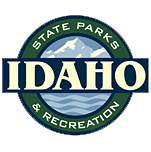These classes are divided into classroom and field exercises and are held regularly during winter months. For information about dates of classes in your region, contact your region coordinator:
Northern Idaho
Office: (208) 769-1511
Cell: (206) 234-7793
Southeast Idaho
Mike Taylor
Office: (208) 769-1511
Cell: (208) 416-3119
Southwest Idaho
Rich Gummersall
Rich Gummersall
(208) 514-2414
5 key safety guidelines when riding in avalanche terrain
- GET THE GEAR: Ensure everyone has an avalanche transceiver, shovel, and probe on their person and knows how to use them.
- GET THE TRAINING: Take an avalanche course.
- GET THE FORECAST: Make a riding plan based on the current avalanche and weather forecast.
- GET THE PICTURE: If you see recent avalanche activity unstable snow exists. Riding on or underneath slopes is dangerous.
- GET OUT OF HARM’S WAY: One at a time on all avalanche slopes. Don’t go to help your stuck friend. Don’t group up in runout zones.
Avalanche Equipment
Make sure you and the people you ride with carry and know how to use the following avalanche equipment:
- Avalanche transceiver
- Backcountry snow shovel
- Avalanche probe
- Backpack to keep gear on snowmobiler, not machine
8 Steps to reducing your Avalanche Risk
- Get smart! The smart first step is to learn from the avalanche experts. This will take a commitment of time and effort on your part. Divide the task into three parts. First, take an avalanche course. Second, check out the videos on avalanche safety. Third, do some reading and expand on what you have learned.
- Utilize your resources.
- WWW.AVALANCHE.ORG
- Sawtooth Avalanche Center (208) 622-8027
- Idaho Panhandle Avalanche Center (208) 765-7323
- Payette Avalanche Center (208) 634-0409
- Identify avalanche terrain. Avalanches run repeatedly year after year in the same areas/slopes called avalanche paths. Avalanches most often start on slopes of 30-45 degrees but sometimes start on slopes as shallow as 25 degrees and as steep as 50 degrees. Knowing the slope angle is “rule number one” in recognizing avalanche terrain, for once slope angles reach 30 degrees, you are in potential avalanche terrain regardless of all other factors.
- Read nature’s signs. Sometimes the snow shows clear and present danger signs of avalanche. Some signs are a fresh avalanche, snow collapsing beneath you or creating noticeable cracks. Some weather signs that the hazard could be worsening fast are heavy snowfall — more than one inch per hour — or strong winds creating blowing snow and snow plumes off the ridges.
- Test the snow. Look for test slopes where you can dig snowpits and perform stress tests. A test slope is a small, steep slope, preferably 30 degrees or steeper, where you will not be in danger of causing an avalanche, but is close to a larger slope that you are concerned about. You can learn all about snowpits while attending Idaho Parks and Recreations Avalanche Awareness course.
- Travel smart. There are several rules of safe backcountry travel that will help to minimize your avalanche risk. One at a time. Only one person at a time should go onto the slope. Avoid the center. The greatest danger on any steep slope comes when you are in the middle of it. Stay on shallow slopes. You can always travel on avalanche-free slopes up to 25 degrees. Never ride alone.
- Take your pulse. In other words, check your attitude. It can get you in trouble. Are you so goal-oriented to climb this peak or highmark that slope that you are willing to take unwarranted risk? Do not overlook clear and present danger signs! Do not fall into peer pressure! Are you letting haste or fatigue get you in trouble? To prevent accidents from happening, you must control the human factor in your decision-making. Know your limitations.
- Be ready for rescue. There are three parts to the rescue equation that will reduce your risk: what equipment to carry, what to do if you are caught, and what to do if a friend is caught.
Rescue gear. A snow shovel, probe and a beacon are the items that everyone who goes into the backcountry should not be without. Do not abandon the search or send searchers out for additional help: You are the buried victim’s best chance for survival.
Snowmobile safety basics
- Let someone know where you are going and when you expect to return.
- Always keep to the right on snowmobile trails.
- Don’t ride alone; two snowmobiles traveling together are much safer than one.
- Don’t drink alcohol and ride.
- Always carry basic emergency and survival equipment (below).
- Be familiar with your snowmobile; try short trips and practice in open areas to become thoroughly familiar with its controls and operation before going on extended trips.
- Always wear adequate winter clothing and protective glasses, goggles or face shields. Use sun screen to protect your skin from sunburn.
Snowmobile survival kit
- Avalanche transceiver, probe and shovel
- Waterproof matches in a waterproof container
- Several disposable lighters
- Cell phone
- Plastic whistle
- Map, compass, GPS
- Small flashlight with extra batteries
- 50 feet of 1/4-inch rope
- First aid kit
- Space blanket
- Candles
- High energy food
- Signal mirror
- Knife
- Metal cup
- Folding saw
- Extra drive belt, spark plugs and tool kit
- Tarpaulin or plastic windbreak
ver: 3.5.2 | last updated:



